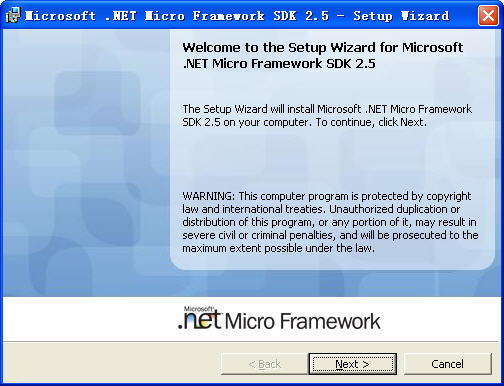.Net Micro Framework SDK 2.5 发布
安装最新版本的SDK之前,需要卸载掉原来的老版本。

安装后,我初步看了一下,好像大的改动不多,以前我编写的MF程序都可以正常运行,至于新功能嘛,其发布文件上如是说:
===============================================================================
What new in V2.5?
===============================================================================
The V2.5 release includes a optionally installed beta release of the assemblies
for the .NET managed Devices Profile for Web Services (DPWS) stack.
Samples demonstrating how to create or use:
- hosted services on devices
- clients on the desktop and on devices
- Discovery and Eventing
The .NET Micro Framework DPWS stack requires TCP/IP (Sockets) to function.
Device firmware must be developed with the V2.5 version
of the .NET Micro Framework Porting Kit in order to include
the .NET Micro Framework TCP/IP network stack.
===============================================================================
Issues
===============================================================================
-------------------------------------------------------------------------------
Issue:
Calling SocketConnect on a second set of sockets causes an exception in the
Emulator.
Resolution:
This is a known issue and will be fixed in a subsequent release.
-------------------------------------------------------------------------------
Issue:
If a DispatchTimer is declared on the stack of a method, and the method
returns, the DispatchTimer object may be garbage collected, even though
still enabled.
Resolution:
Declare DispatchTimer objects as globals.
-------------------------------------------------------------------------------
Issue:
The EnableDynamicDNS method of the
Microsoft.SPOT.Net.NetworkInformation.NetworkInterface class is not
implemented in the .NET Micro Framework TCP/IP stack, and will cause
an exception if called from a managed application.
Resolution:
Dynamic DNS address assignment is accomplished by enabling DHCP after
setting the static DNS address to 0.0.0.0.
For example, the following code will cause DHCP to assign the DNS addresses:
// set DNS to 0 so DHCP DNS is used
string[] dns = new string[] { "0.0.0.0", "0.0.0.0" };
interfaces[0].EnableStaticDns(dns);
// Enable DHCP
interfaces[0].EnableDhcp();
When changing the network configuration in a managed application, it is
necessary to follow these guidelines:
1) When changing the network configuration from DHCP-enabled to static,
it is necessary to update the static DNS addresses
2) When changing the network configuration from static to DHCP-enabled,
it is necessary to change the two DNS addresses to 0.0.0.0 so that DHCP
will update the DNS addresses. If you want to then replace the
DNS addresses provided by DHCP, call EnableStaticDns with the two
replacement addresses.
-------------------------------------------------------------------------------
Issue:
DHCP behavior on the .NET Micro Framework differs from DHCP on the desktop.
The .NET Micro Framework makes three attempts within 7 seconds to obtain
a DHCP lease at bootup. If the DHCP server is not found within this time frame,
the framework ceases searching for a DHCP server. This is the intended behavior
that application developers should be aware of since it differs from all
versions of the Windows operating system.
Because of the finite number of attempts to find the DHCP server, your device
may not obtain a DHCP lease if it is not properly connected to the network at
boot time.
Resolution:
Connect the device to the network before booting.
-------------------------------------------------------------------------------
Issue:
Deploying multiple times to the iMXS platform in Visual Studio can cause
deployment errors.
Resolution
A solution to this problem is being investigated for version 3.0. Currently,
there are multiple workarounds available. Here are a few.
1. Press F5.
2. Restart the device.
3. Check to see if you have multiple devices with the same name.
4. Restart Visual Studio.
-------------------------------------------------------------------------------
Issue:
There is a known issue when debugging a .NET Micro Framework V2.0 SP1
application running on the V2.5 firmware. This typically happens when loading
a resource. This issue will be resolved in a subsequent release.
Resolution
Use the V2.5 SDK for all application development.
-------------------------------------------------------------------------------
Issue:
Dns.GetHostEntry with an empty input string ("") will return the local
IP address
Resolution:
This is by design and expected behavior.
-------------------------------------------------------------------------------
Issue:
After deploying an application from Visual Studio, the device is rebooted. In
some cases, DHCP can cause Visual Studio to time out while waiting for a
reconnect, preventing Visual Studio from debugging the device.
Resolution:
Add a registry key and value to increase the amount of time Visual Studio will
wait for a reconnect. The default of 5 seconds may be extended by creating the
following key and setting its timeout, retries, and override values:
HKCurrentUser\
Software\
Microsoft\
.NetMicroFramework\
NonVersionSpecific\
Timing\
AnyDevice
'timeout' (DWORD): milliseconds to wait before retrying
(constrained to 50 < timeout < 60000)
'retries' (DWORD): count of retries to attempt
(constrained to 1 < retries < 1000)
'override' (DWORD): if present and non-zero, ignore constraints above,
and attempt to apply any valid DWORD values.
If any one of the values provided is out of bounds or malformed, it is
silently ignored and the default values remain in effect. However, the others
that are valid are still be applied.
The default values are as in v2 SP1: timeout = 100 for platforms that support
a soft reboot, 1000 otherwise; retries = 10.
-------------------------------------------------------------------------------
Issue:
Calling a NetworkInterface method that changes the IP address will invalidate
any bound sockets.
Resolution:
If running as a server, re-bind any open sockets after any IP address change.
进一步的详情,等我研究后在说。





【推荐】国内首个AI IDE,深度理解中文开发场景,立即下载体验Trae
【推荐】编程新体验,更懂你的AI,立即体验豆包MarsCode编程助手
【推荐】抖音旗下AI助手豆包,你的智能百科全书,全免费不限次数
【推荐】轻量又高性能的 SSH 工具 IShell:AI 加持,快人一步
· go语言实现终端里的倒计时
· 如何编写易于单元测试的代码
· 10年+ .NET Coder 心语,封装的思维:从隐藏、稳定开始理解其本质意义
· .NET Core 中如何实现缓存的预热?
· 从 HTTP 原因短语缺失研究 HTTP/2 和 HTTP/3 的设计差异
· 周边上新:园子的第一款马克杯温暖上架
· Open-Sora 2.0 重磅开源!
· 分享 3 个 .NET 开源的文件压缩处理库,助力快速实现文件压缩解压功能!
· Ollama——大语言模型本地部署的极速利器
· DeepSeek如何颠覆传统软件测试?测试工程师会被淘汰吗?